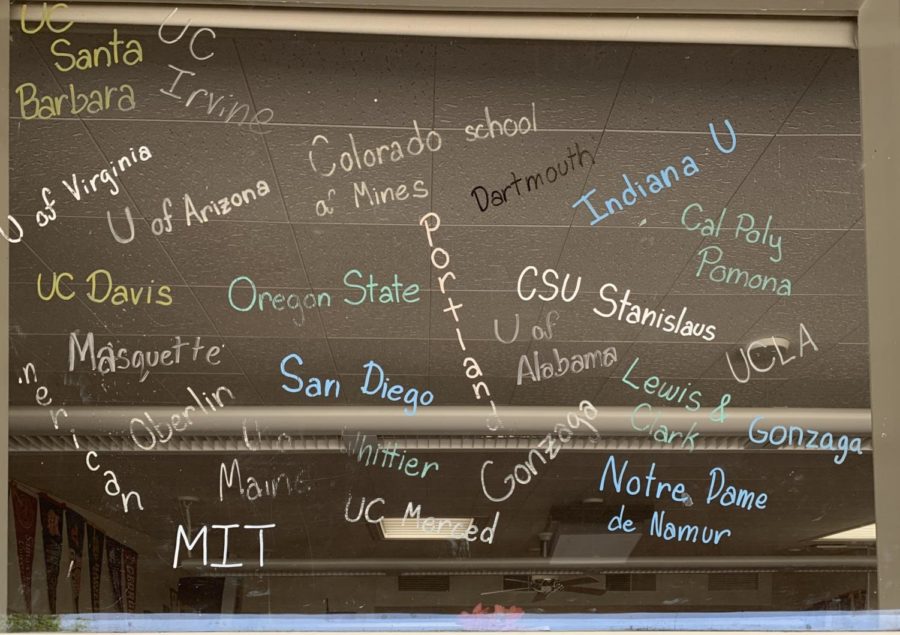Once high school seniors receive their college acceptances, the joy only lasts a few moments. Then, the fear and confusion of committing to a college, applying for scholarships and financial aid, putting down deposits for housing, and tying up any loose ends at high school overwhelm students.
Woodside students have access to the College and Career Center in D-9, where Counselor Zorina Matavulj works. Her job is to support students with the entire college application and acceptance process, and she’s here to help!
“The most important thing to do at that point … is celebrate,” Matavulj said. “Congratulations! But, there are a couple things that you want to keep in mind. May 1 is the universal commitment date, so everybody has to say yes to the school that they want to go to.”
Committing to a college is the first step. However, waitlists and rejections raise questions for students.
“10 years ago, hardly anybody was on a waitlist,” Matavulj said. “Colleges didn’t need waitlists, but now they love them. Oftentimes with waitlists, you have to say that you want to be on it. Make sure you meet all the requirements that they’re requesting.”
For students who got waitlisted for their top school, Co-Head Guidance Counselor Jaqueline Grimaldi offers some clarity.
“Definitely accept the waitlist offer,” Grimaldi said. “If you don’t do anything, you might not be on the list. Then, see if they accept an additional essay or any new information you have for them. You can submit those essays and submit new grades from first semester senior year.”
These essays explain why you like that school and what you have done since the application due date that you think will boost your application help get you off the waitlist. However, Matavulj admits that students shouldn’t count on getting off a school’s waitlist.
“I have to be very, very real,” Matavulj said. “It’s not impossible, but it’s extremely unlikely, especially if you don’t have something new or different to share with the college.”
For students who may have not gotten into their top college, Matavulj explains the community college route, which increases students’ chances of getting into their dream school through the transfer process as a college sophomore.
“The admit rate for seniors in high school is always much, much lower than the admit rate for transfers from a community college,” Matavulj said.
Through the Transfer Admission Guarantee (TAG), community college students who get 60 units with a C or higher are automatically admitted into one of the six UCs participating (Davis, Irvine, Merced, Riverside, Santa Barbara, and Santa Cruz).
“Students who want to go to the nonparticipating UCs often just apply anyways, and the answer oftentimes is yes,” Matavulj said. “The state of California came up with a Master Plan to educate our residents as much as we possibly can. They’re incentivizing community college students to go to a four year college by making the state public schools promise that they’re going to take however many students are applying to transfer.”
One of the benefits of going to community college is that the general or pre-requisite classes will be smaller than on a four-year campus, and once the student transfers into a UC, they can jump right into specialized major classes.
“The hard part is that you miss out on college life,” Grimaldi said. “But, you can make that at a community college. Community colleges also have student life. They have student government, different organizations, clubs, things like that.”
Nevertheless, many seniors plan on entering a four-year college right after high school. When deciding, the location and the campus often play a large part in college decisions. For a quick overview of the campus, Matavulj recommends simply visiting the college’s website and taking a virtual tour.
“A virtual tour is absolutely positive because it gives you some information about the different things on campus, the different programs that they offer, and different housing possibilities,” Matavulj said. “The difference with in-person tours is that you get to feel the vibe and the atmosphere of the campus that can’t be felt through the screen. … I just remember when I stepped onto Michigan’s campus, I was like, this is my school.”
Another concern for many students is the financial side of college. Everyone’s heard of the student loan horror stories, so Matavulj advises students to look at the total cost per year, including tuition, room and board, meal plans, etc, and also look at what financial aid the school is offering, and scholarship opportunities to hopefully bridge the gaps between the final cost and the student’s budget. There are a few scholarship packets still available at the College and Career Center (D-9) and outside of both Ms. Camera’s room (E-9) and Ms. Macioce’s room (E-22). Those are general scholarships that Woodside students have historically won.
“If that final cost is comfortable for me and my family, great!” Matavulj said. “Still, no matter what, go to the financial aid office on campus. There are so many scholarships available directly from the college made for incoming students.”
Students had the opportunity to submit the Free Application for Student Aid (FAFSA) in March.
“If you haven’t done that yet, you can still submit it,” Grimaldi said. “The college will give you a financial aid package based on what you entered in the application. In your portal, they’ll list their offers, which can include grants or loans or other aid. It’s up to the student to see if they want to take them or not.”
Colleges have also made accessing financial aid much easier. Almost every college will have a financial aid website to learn about college-specific scholarships.
“If your financial aid packet isn’t enough, connecting with financial aid officers by calling the office can often get you more money,” Matavulj said. “Most of the time, you just need to fill out a form letting the college know that you need more support.”
Aside from the cost of tuition, room and board is the second most expensive part of college.
“Colleges are businesses,” Matavulj said. “They need money to provide clean dorms and clean housing, and housing deposits are one of the ways they get revenue as early as possible. Many colleges make the requirement for housing before the May 1 commitment date because it helps them estimate how many students will end up committing.”
It’s also important to apply for housing early because you’ll be more likely to get your desired housing. Most colleges have tiered housing, where the cheapest level have rooms with two or three roommates and a shared bathroom with your floor, and the most expensive rooms have larger accommodations and a more private bathroom.
“When students commit to housing early, they’re more likely to be comfortable with what they want in terms of housing,” Matavulj said. “Plus, you can find roommates online now, through Instagram and Facebook, which feels awkward at the beginning but is actually a huge benefit. You are taking control of your living situation rather than the college randomly figuring it out. It’s going to end up benefiting you.”
Finally, high school seniors need to close the book on their high school career. This includes submitting final transcripts and AP/SAT scores, if applicable.
“Your final college will request your high school transcripts, along with any college transcripts if you’ve taken community college classes,” Grimaldi said. “[The counseling office] will ask you what your college will be in either a Google form or paper form so that we can make sure we send the transcript to that school. We also ask students to request a final transcript on Naviance once they’ve committed, just so we have two points of reference.”
While many schools went test optional for this round of applications, many chose to still report their scores.
“If you listed your scores on your application, that was what the college looked at,” Grimaldi said. “Now they’re going to ask for verification. They’re going to ask you to email or send your scores directly through the CollegeBoard website.”
The CollegeBoard website lets you send your AP scores for free to one college, and you can send your SAT scores through this website.
Ultimately, going to college is a big deal. It can feel overwhelming, but the hard part (applying) is over now. Finish up these last few tasks, and you’re collegebound!
Congratulations, Woodside seniors!









